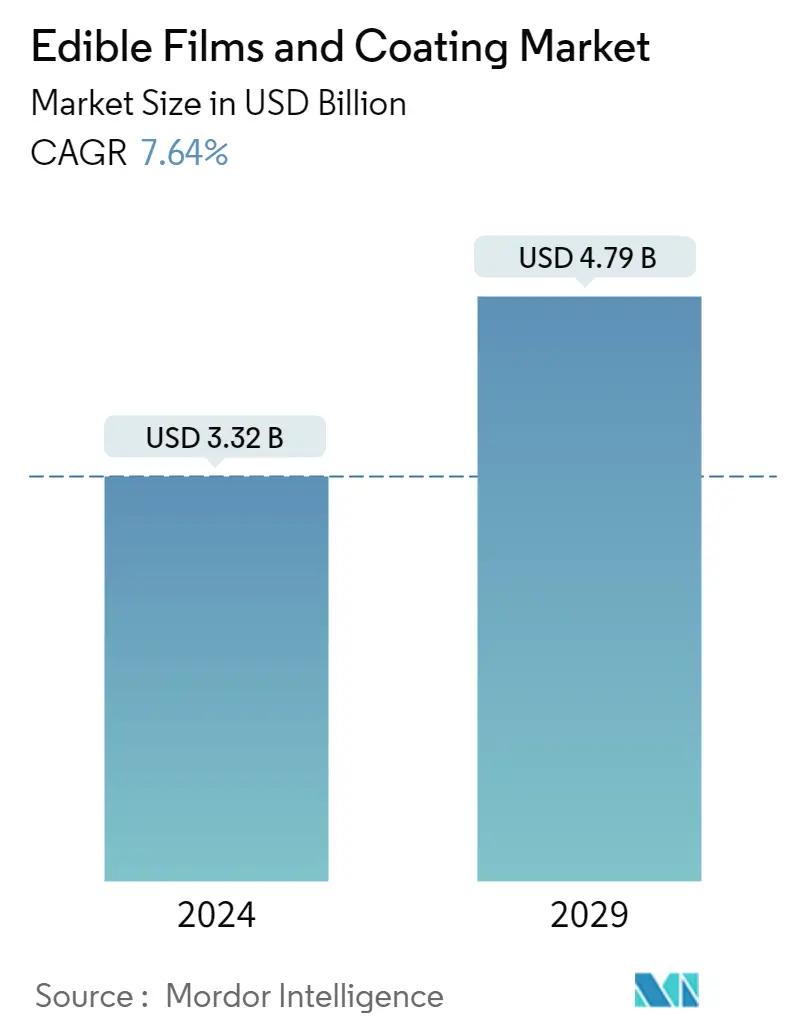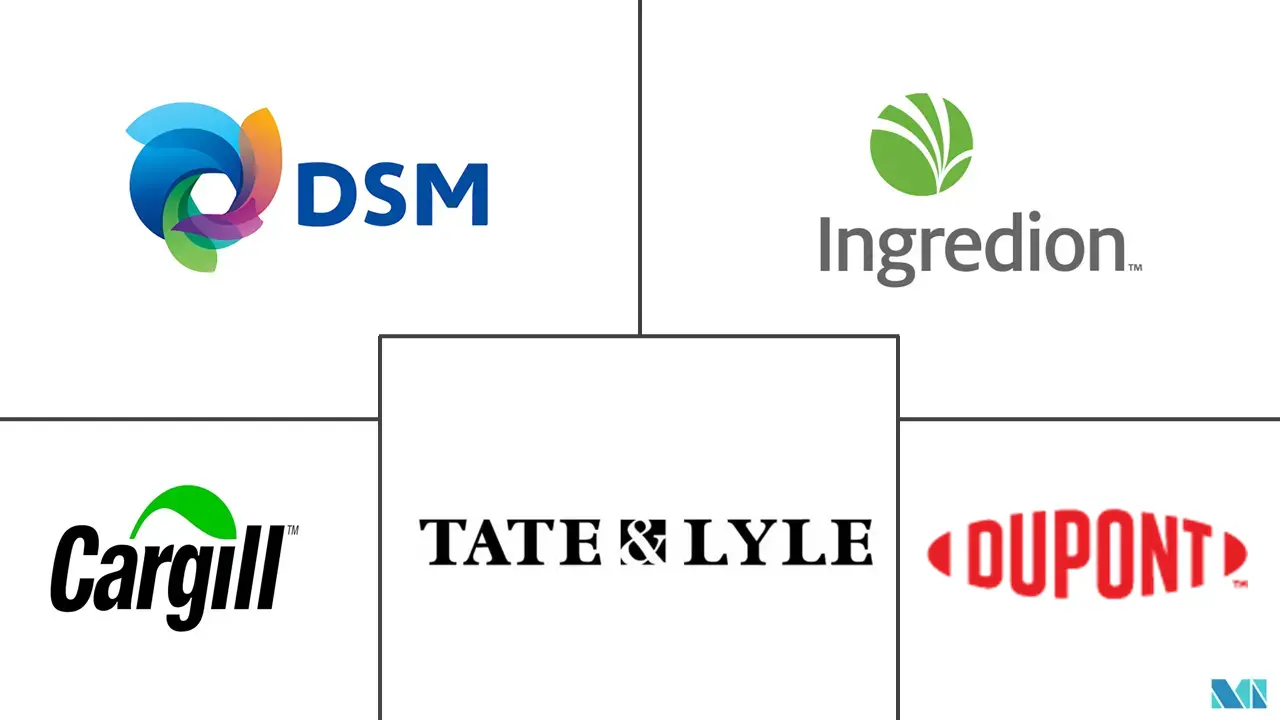Market Size of Edible Films and Coating Industry

| Study Period | 2018 - 2029 |
| Market Size (2024) | USD 3.32 Billion |
| Market Size (2029) | USD 4.79 Billion |
| CAGR (2024 - 2029) | 7.64 % |
| Fastest Growing Market | South America |
| Largest Market | Asia Pacific |
Major Players
*Disclaimer: Major Players sorted in no particular order |
Edible Films & Coatings Market Analysis
The Edible Films and Coating Market size is estimated at USD 3.32 billion in 2024, and is expected to reach USD 4.79 billion by 2029, growing at a CAGR of 7.64% during the forecast period (2024-2029).
- The benefit of using edible coating on food products is that it acts as a barrier for carbon dioxide, lipids, moisture, oxygen, and aromas. It improves food quality and extends the shelf life of products. One major advantage of using edible films and coatings is that several active ingredients can be incorporated into the polymer matrix and consumed with food, thus, enhancing safety or even nutritional and sensory attributes. The edible coatings can be made from soybean protein, wheat gluten, whey, gelatin, and many more.
- Demand for plant-based food products is increasing among consumers because of their benefits and health consciousness. The food product manufacturers have increased their efforts to increase the shelf life and improve the existing packaging technology, ensuring the microbial safety and preservation of food from the influence of external factors. Technological institutes and researchers are innovating new technologies to develop edible films with the use of different components.
- For instance, in September 2022, the Indian Institute of Technology, Guwahati, developed an edible coating to extend the shelf life of fruits and vegetables. The coating is made from a mix of microalgae extract and polysaccharides. The marine microalgae Dunaliella tertiolecta, known for its antioxidant properties, is used for its various bioactive compounds such as carotenoids, proteins, and polysaccharides. Thus, new product innovations from manufacturers are expected to contribute to the market growth of the edible films and coatings market.
Edible Films & Coatings Industry Segmentation
Edible films and coatings are thin layers of edible materials applied to food products that play an important role in their conservation and distribution. Some of their functions are to protect the product from chemical and microbiological activities.
The edible films and coating market is segmented into ingredient type, application, and geography. Based on ingredient type, the market is segmented into protein, polysaccharides, lipids, and composites. Based on application, the market is segmented into dairy products, bakery and confectionery, fruits and vegetables, meat, poultry and seafood, and other applications. By geography, the market is segmented into North America, Europe, Asia-Pacific, South America, and the Middle East and Africa.
For each segment, the market sizing and forecasts have been done on the basis of value (USD million).
| Ingredient Type | |
| Protein | |
| Polysaccharides | |
| Lipids | |
| Composites |
| Application | |
| Dairy products | |
| Bakery and Confectionery | |
| Fruits and Vegetables | |
| Meat, Poultry, and Seafood | |
| Other Applications |
| Geography | ||||||||
| ||||||||
| ||||||||
| ||||||||
| ||||||||
|
Edible Films and Coating Market Size Summary
The edible films and coatings market is experiencing significant growth, driven by the increasing demand for sustainable and effective food packaging solutions. These films and coatings serve as barriers to carbon dioxide, lipids, moisture, oxygen, and aromas, thereby enhancing food quality and extending shelf life. The market is benefiting from the rising consumer preference for plant-based food products, which has prompted manufacturers to innovate and improve packaging technologies. Edible coatings made from natural ingredients such as soybean protein, wheat gluten, and marine microalgae are gaining traction, with research institutions developing new formulations to enhance the preservation of fruits and vegetables. This trend is further supported by the growing awareness of sustainability and food safety among consumers, which is influencing purchasing decisions and regulatory standards.
The market landscape is characterized by a mix of global and regional players, with major companies like DuPont de Nemours Inc, Tate & Lyle, and Cargill, Incorporated leading the charge. Innovations in edible packaging, such as the use of silk proteins and biodegradable emulsions, are contributing to the market's expansion. The demand for polysaccharide-based films and coatings is particularly high in regions like China and Japan, where traditional packaging materials are being replaced by more sustainable alternatives. The market is expected to see continued growth and innovation, with potential mergers and acquisitions as new brands emerge and gain traction. This dynamic environment is poised to offer more advanced and eco-friendly packaging solutions in the coming years.
Edible Films and Coating Market Size - Table of Contents
-
1. MARKET DYNAMICS
-
1.1 Market Drivers
-
1.2 Market Restraints
-
1.3 Porter's Five Forces Analysis
-
1.3.1 Threat of New Entrants
-
1.3.2 Bargaining Power of Buyers/Consumers
-
1.3.3 Bargaining Power of Suppliers
-
1.3.4 Threat of Substitute Products
-
1.3.5 Intensity of Competitive Rivalry
-
-
-
2. MARKET SEGMENTATION
-
2.1 Ingredient Type
-
2.1.1 Protein
-
2.1.2 Polysaccharides
-
2.1.3 Lipids
-
2.1.4 Composites
-
-
2.2 Application
-
2.2.1 Dairy products
-
2.2.2 Bakery and Confectionery
-
2.2.3 Fruits and Vegetables
-
2.2.4 Meat, Poultry, and Seafood
-
2.2.5 Other Applications
-
-
2.3 Geography
-
2.3.1 North America
-
2.3.1.1 United States
-
2.3.1.2 Canada
-
2.3.1.3 Mexico
-
2.3.1.4 Rest of North America
-
-
2.3.2 Europe
-
2.3.2.1 United Kingdom
-
2.3.2.2 Germany
-
2.3.2.3 France
-
2.3.2.4 Italy
-
2.3.2.5 Spain
-
2.3.2.6 Rest of Europe
-
-
2.3.3 Asia-Pacific
-
2.3.3.1 India
-
2.3.3.2 China
-
2.3.3.3 Japan
-
2.3.3.4 Australia
-
2.3.3.5 Rest of Asia-Pacific
-
-
2.3.4 South America
-
2.3.4.1 Brazil
-
2.3.4.2 Argentina
-
2.3.4.3 Rest of South America
-
-
2.3.5 Middle-East and Africa
-
2.3.5.1 South Africa
-
2.3.5.2 Saudi Arabia
-
2.3.5.3 Rest of Middle-East and Africa
-
-
-
Edible Films and Coating Market Size FAQs
How big is the Edible Films and Coating Market?
The Edible Films and Coating Market size is expected to reach USD 3.32 billion in 2024 and grow at a CAGR of 7.64% to reach USD 4.79 billion by 2029.
What is the current Edible Films and Coating Market size?
In 2024, the Edible Films and Coating Market size is expected to reach USD 3.32 billion.

